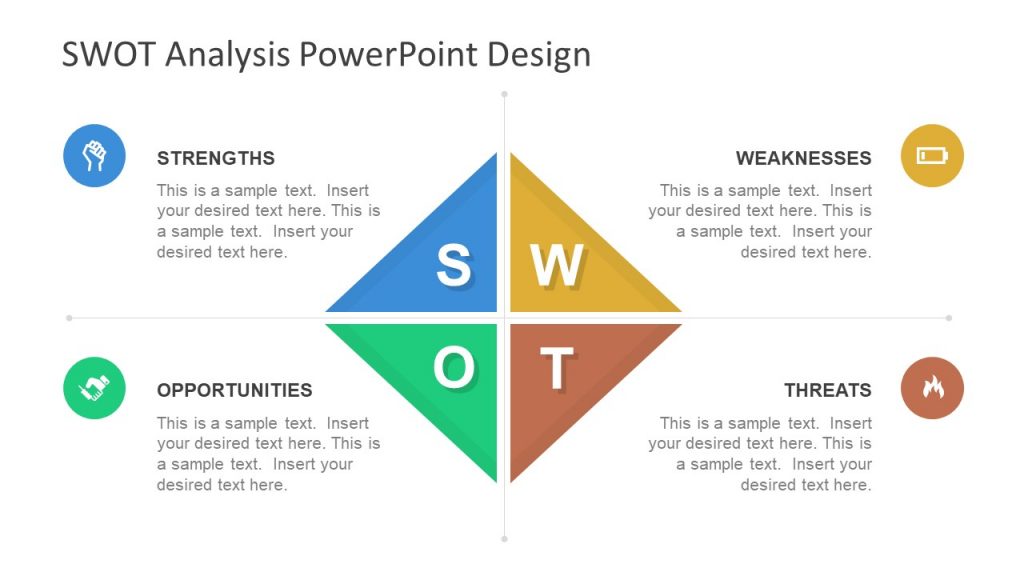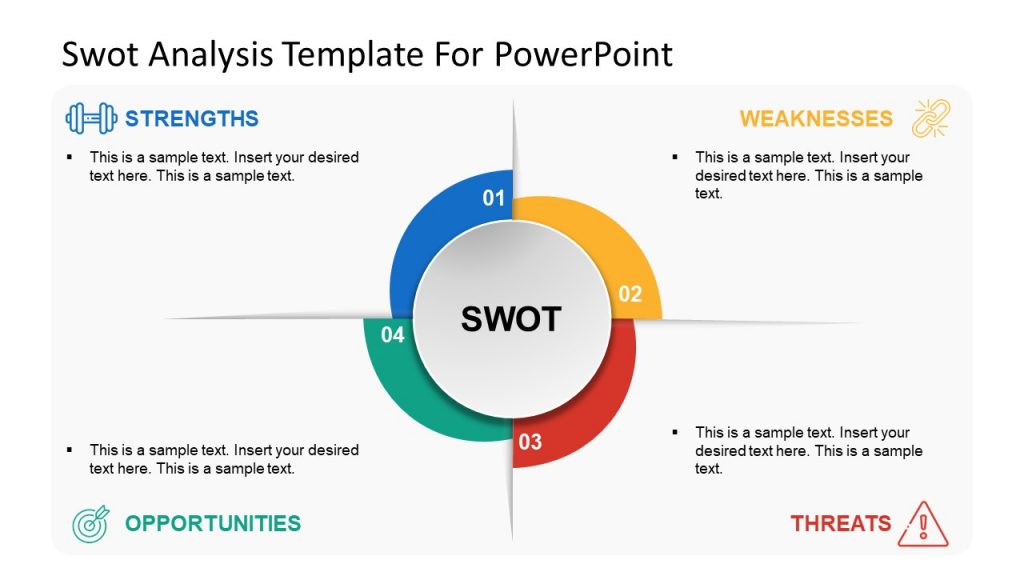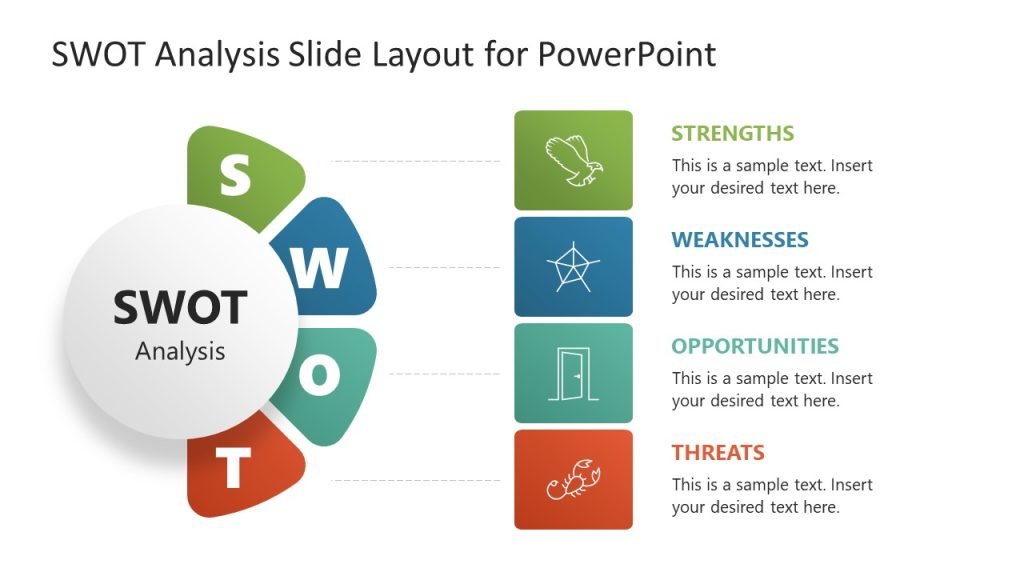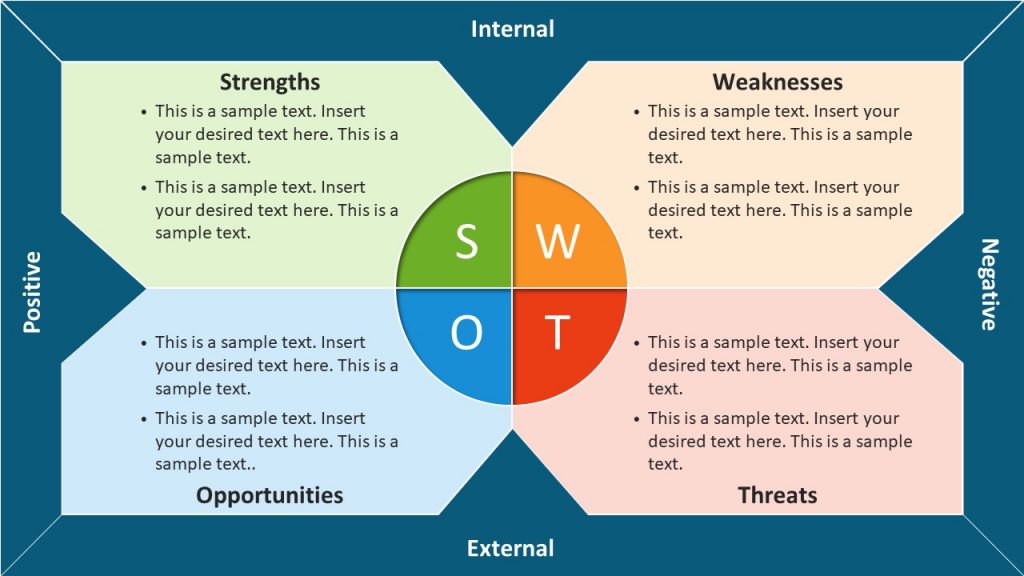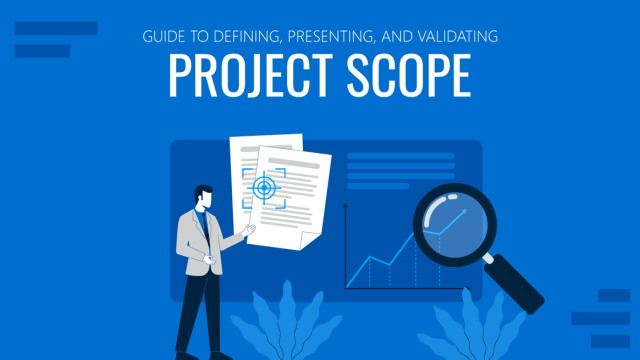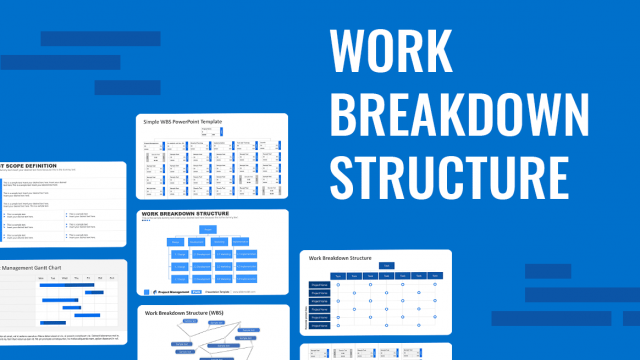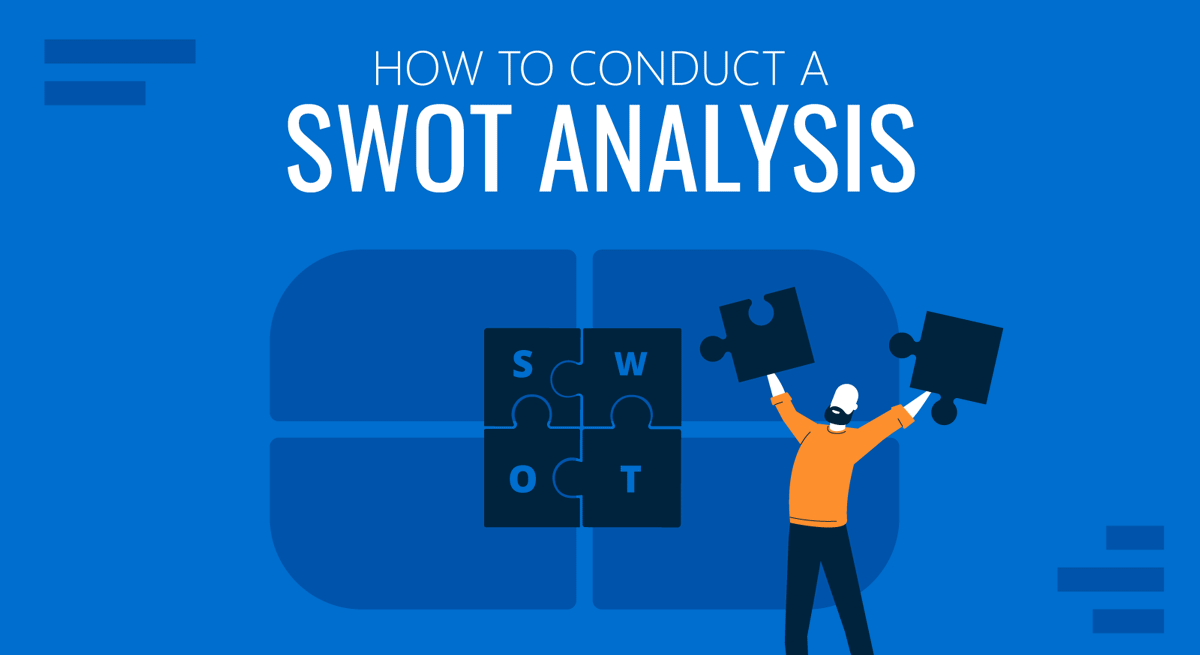
Self-awareness is crucial for running a successful business. You probably know this by now; when you understand your business needs and faults, you can take appropriate actions and fix all your problems. The real question, however, lies in how to cultivate that understanding. So, how can businesses better know themselves?
Several techniques may help businesses asses their shortcomings and strong suits, but a SWOT analysis is arguably the most commonly used. In this article, you will learn how to utilize this tool for your business as you embark on a transformative journey.
Table of Contents
- What Is a SWOT Analysis?
- Anatomy of a Perfect SWOT Analysis
- Internal and External Factors in SWOT Analysis
- How to Conduct a SWOT Analysis
- How to Use SWOT Analysis Results
- Case Study: SWOT Analysis for Marketing
- Case Study: SWOT Analysis for Design Thinking
- Presenting SWOT Analysis
- SWOT Analysis Alternatives
- Conclusion
What Is a SWOT Analysis?
SWOT analysis is a strategic planning tool that helps businesses evaluate their Strengths and Weaknesses, as well as Opportunities and Threats – hence the acronym SWOT. It involves evaluating both internal and external factors that impact the organization.
You might have performed a personal SWOT analysis in the past – the goal is somewhat similar to an organizational SWOT. By conducting a SWOT analysis, you can identify the current competitive advantages of your business and devise a successful strategy for the future. SWOT can also uncover the factors and competitive risks hindering the business’s growth.
This simple matrix model can be applied to various aspects of an organization, including its products, projects, and reputation. Its simplicity and effectiveness have contributed to its popularity, making it widely used in project management practices.
Anatomy of a Perfect SWOT Analysis
The SWOT analysis template is presented as a 2×2 grid or 4-column table, with each part corresponding to one of the four elements: strengths, weaknesses, opportunities, and threats. Here’s an overview of how the SWOT matrix is structured.
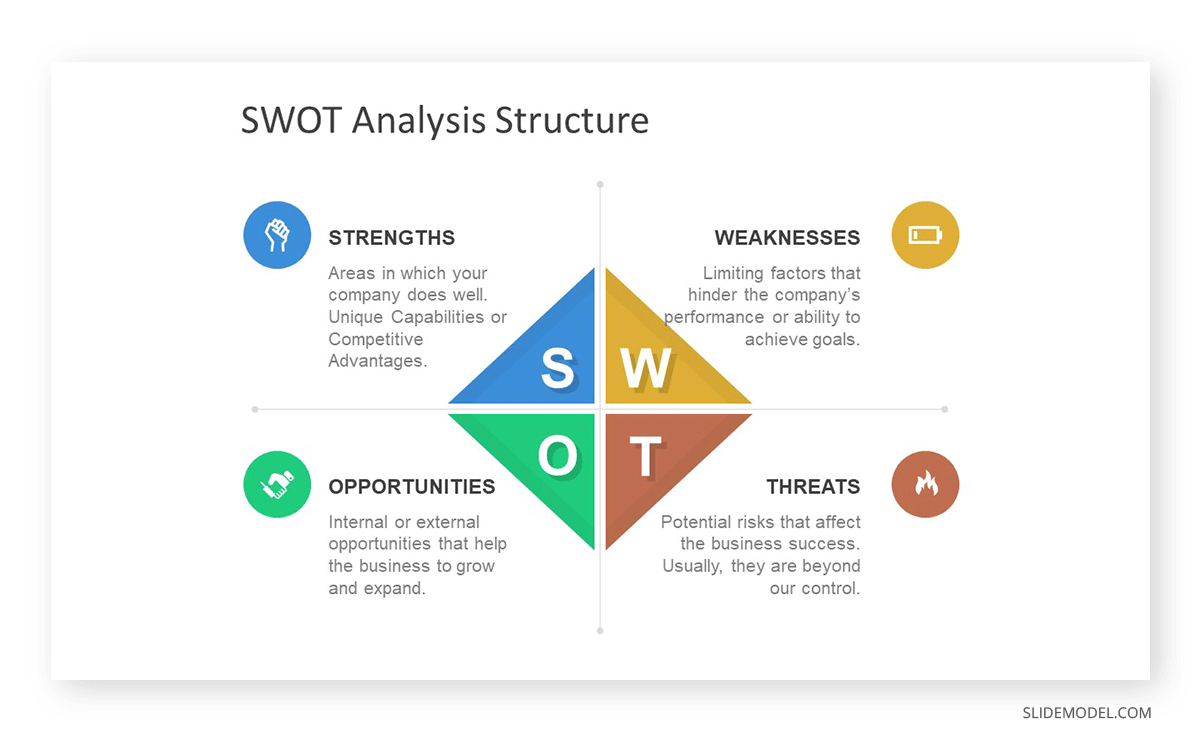
Strengths
SWOT analysis requires you to identify and analyze the strengths of your business. This includes recognizing what your company does particularly well, such as unique capabilities, competitive advantages, strong brand reputation, or exceptional resources. Understanding these strengths will help your organization capitalize on its existing advantages.
To get your thinking started, ponder these questions and consider the following points:
- What do we do exceptionally well?
- What advantages do we have over our competitors?
- What unique resources or capabilities do we possess?
When evaluating strengths, it’s also essential to consider them concerning your competitors. Simply having the same capabilities or features as your competitors does not provide a competitive advantage and cannot be considered a strength. Instead, strengths should highlight areas where your business outperforms or differentiates itself from competitors.
Weaknesses
In the context of SWOT analysis, weaknesses refer to factors or limitations within your organization that may hinder your performance or ability to achieve your objectives. Weaknesses are identified by carefully assessing the organization’s resources, processes, skills, and other internal aspects.
During this process, you must examine every aspect of your business objectively. Let go of preconceived notions about your organization and try to answer the following questions without bias.
- What do our competitors do better than us?
- What internal limitations or challenges do we face?
- What should we avoid or minimize to be successful?
Remember, objectivity doesn’t mean dismissing positive aspects or overlooking achievements. It means being honest and realistic about the current state of your business and using weaknesses as opportunities for growth and development.
Opportunities
The opportunities quadrant is often the hardest to fill in in the SWOT template because they come from various sources and avenues.
Analyzing opportunities revolves around resources that can be utilized to drive growth and enhance performance. They may arise within the company, like leveraging core competencies or investing in employee development. They may also be external factors that are not within the direct control of the organization, e.g., emerging technologies, new market segments, or changes in consumer behavior.
Identifying and capitalizing on these opportunities can help your business grow and expand. So, to identify these opportunities, ask yourself:
- What emerging trends or market opportunities can we capitalize on?
- Are there any untapped customer segments or unmet needs?
- Are there favorable economic or industry conditions we can leverage?
- Can we leverage advancements in technology to our advantage?
Filling in the opportunities quadrant may require creative thinking, exploration, and a forward-looking mindset. The key to this endeavor is to monitor the business environment continuously, stay open to new possibilities, and be proactive.
Threats
Threats are factors that pose potential risks or challenges to the business’s success. They can come from competitors, changing regulations, economic downturns, disruptive technologies, or shifting consumer preferences. While businesses may have limited control over these factors, it is essential to identify and anticipate threats to develop strategies for managing them effectively.
The following questions may help you identify your business’s potential risks or threats.
- Who are our main competitors, and what are their strengths?
- Are there any changes in regulations that may impact our operations?
- What are the shifting customer preferences or market trends that may pose risks?
Internal and External Factors in SWOT Analysis
As mentioned, you’ll normally see the SWOT analysis in a simple matrix. However, some companies adopt an expanded version that compartmentalizes the four elements into internal and external factors.
The organization’s Strengths and Weaknesses fall under the internal factor as their attributes are within the control of the business and can be influenced or modified. For example, your strong brand reputation may be due to past performance and effective processes.
Opportunities and Threats, on the other hand, are considered external factors because they exist outside the organization and are beyond its direct control. An example could be fluctuations in the economy. They can pose opportunities or threats to your company, but you have nothing to do with it; that’s why it’s an external factor.
By categorizing these factors separately, organizations can capitalize on external opportunities or address threats in a way that aligns with their internal capabilities and strengths.
How to Conduct a SWOT Analysis
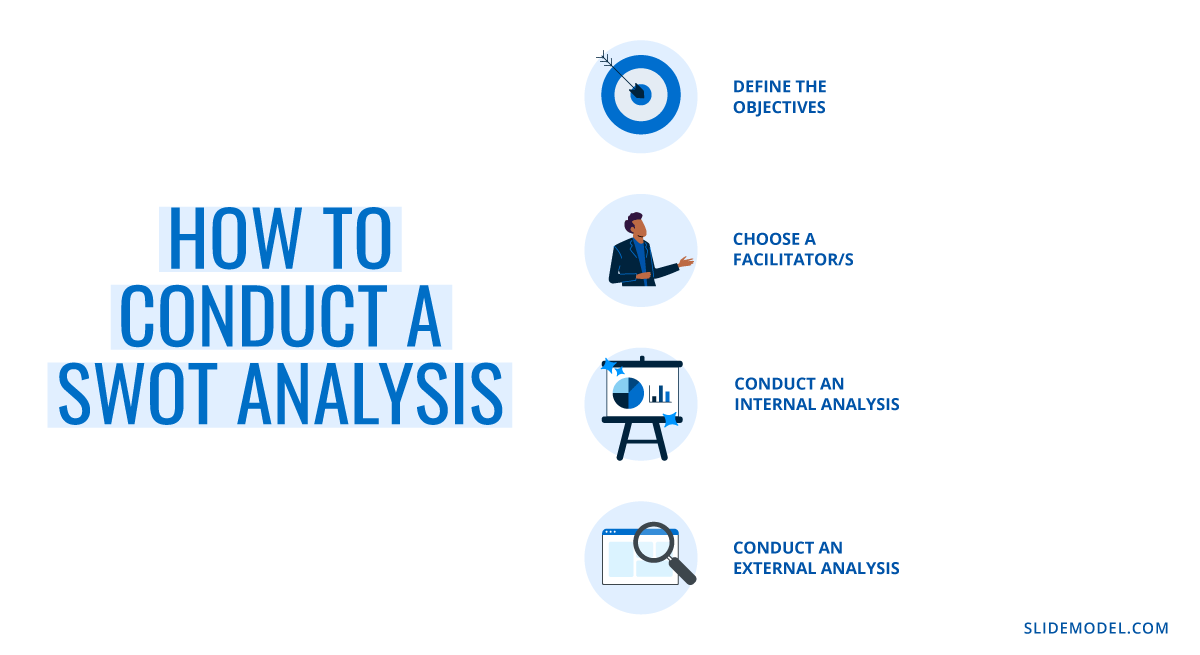
1. Define the Objectives
The first step of conducting a SWOT analysis is putting in place a clear purpose or objective for why you are analyzing in the first place. This goal will provide meaningful guidance when gathering relevant information and ensure that the analysis provides actionable insights for your business.
Your goal could be, for example, to evaluate the feasibility of entering a new market, assess the competitiveness of a product, or identify areas for improvement within the organization.
2. Choose a Facilitator/s
Business owners or organizational leaders should be involved in SWOT analyses. Still, it’s also important to include team members whose skills and roles align with the goal of the particular analysis.
For example, a retail clothing company that wants to enter online sales may involve the following stakeholders in conducting a SWOT analysis.
- Marketing team/manager who can analyze online consumer behavior.
- IT/Technology specialist who can provide insights into the company’s internal technological capabilities and infrastructure.
- Supply chain manager who can evaluate the company’s supply chain capabilities and logistics.
- Customer service representatives who can share the common pain points of the customers.
3. Conduct Internal Analysis
The next step would be collecting relevant data and information about the internal aspects of the organization. This can include financial statements, operational reports, and other data sources that provide insights into the organization’s strengths and weaknesses.
During this activity, gathering perspectives from various stakeholders and sources is crucial to obtain a holistic view of your business. Don’t limit the analysis to internal stakeholders – seek external perspectives as well.
For example, a company redesigning one of its products can implement customer surveys to know what satisfaction, pain points, and suggestions for improvement they have for the existing product. This feedback may be translated into strengths and weaknesses.
4. Conduct External Analysis
Next is to identify the external factors, a.k.a the opportunities and threats, that can influence the organization’s performance and decision-making.
The external analysis aims to gain insights into the broader market conditions, industry trends, customer preferences, competitive landscape, regulatory factors, and other external forces that can impact the organization’s operations and success.
Continuous monitoring is the key here so that you can stay updated on the dynamic nature of the external environment and make timely adjustments to your strategies.
How to Use SWOT Analysis Results
Conducting a SWOT analysis is just the first step in strategic planning. What’s even more important is taking action based on its results. Identifying strategic alternatives using the SWOT result is a key objective to help you explore different courses of action and make informed decisions about your future direction.
You can use the TOWS matrix in this activity, an analysis tool by Heinz Weihrich that builds upon the SWOT analysis. The TOWS Matrix provides a framework for generating strategic alternatives and considering different internal and external factors combinations. It helps organizations think more comprehensively about their strategic choices and enables them to develop effective strategies.
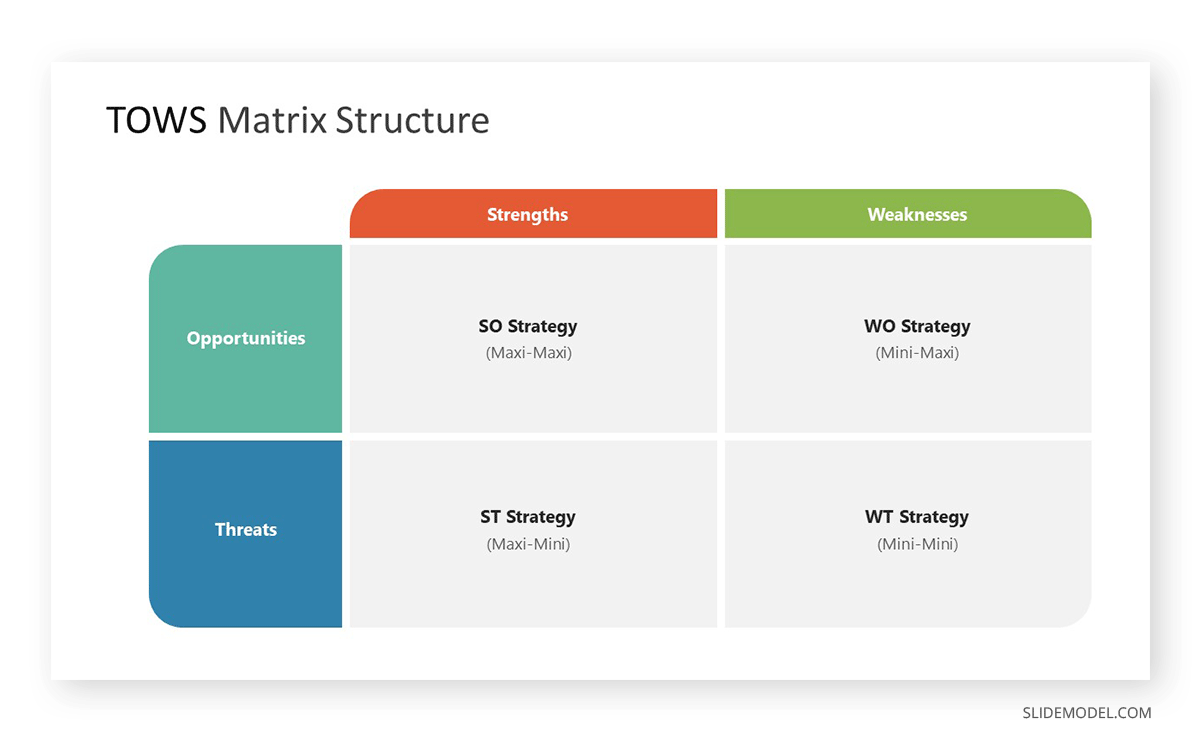
Let’s take a look at how this works.
1. SO: Maximize Strengths and Opportunities
Take time to pare down the factors in the analysis and match your strengths with the opportunities to gain insights for developing an action plan. This approach ensures that you leverage your internal capabilities and resources to exploit the most promising opportunities in the market.
For example, a clothing retail store that has a strong brand reputation online (strength) can take advantage of the growing trend of online shopping (opportunity) by investing in an e-commerce website (action plan).
2. WO: Minimize Weaknesses and Maximize Opportunities
The second strategy in the TOWS matrix allows you to identify your organization’s weaknesses that may prevent you from taking advantage of market demands.
For example, a limited online presence of a retail store (weakness) may hinder them from reaching a broad customer base in the growing e-commerce market (opportunity).
It should be your priority to shore up your weaknesses, so you can fully maximize the opportunities the external environment presents to your business. In the example, the fictitious organization could expand its online marketing campaigns or build an e-commerce website, if they haven’t yet, to take up space in the online shopping industry.
3. ST: Maximize Strengths and Minimize Threats
This strategy is all about using your organization’s strengths to deal with the threats brought about by external factors. For example, a rapid change in the social media landscape (threat) may prevent an online retail store from attracting new customers. But, it can focus on maximizing the value of its loyal customer base (strength) by implementing customer retention strategies while exploring alternative marketing channels.
4. WT: Minimize Weaknesses And Threats
It is a challenging position to be in when a company is confronted with external threats and internal weaknesses. At this point, the goal is to minimize the weaknesses to be in a better position to overcome the threats. For instance, a retail company with limited digital marketing experience (weakness) can partner with an agency to help them navigate the rapidly changing social media landscape (threat).
Case Study: SWOT Analysis for Marketing
Now that we’ve covered the elements that go into a SWOT analysis and what to do with them let’s put them to the test using an example. In this first case, we shall explore a SWOT analysis marketing application.
Imagine this scenario:
Topnotch is a well-established marketing company known for its expertise in digital marketing, social media management, and branding strategies. With a desire to diversify its service offerings and tap into new markets, the company decides to enter a new domain, namely experiential marketing.
They successfully served clients across various industries, but the leadership team recognizes the need to adapt to the evolving demands of the market. Through extensive market research and analysis, the agency identifies experiential marketing as a promising domain with high growth potential.
With the help of a marketing SWOT analysis, they want to identify whether they can afford to pursue this endeavor considering the internal and external factors.
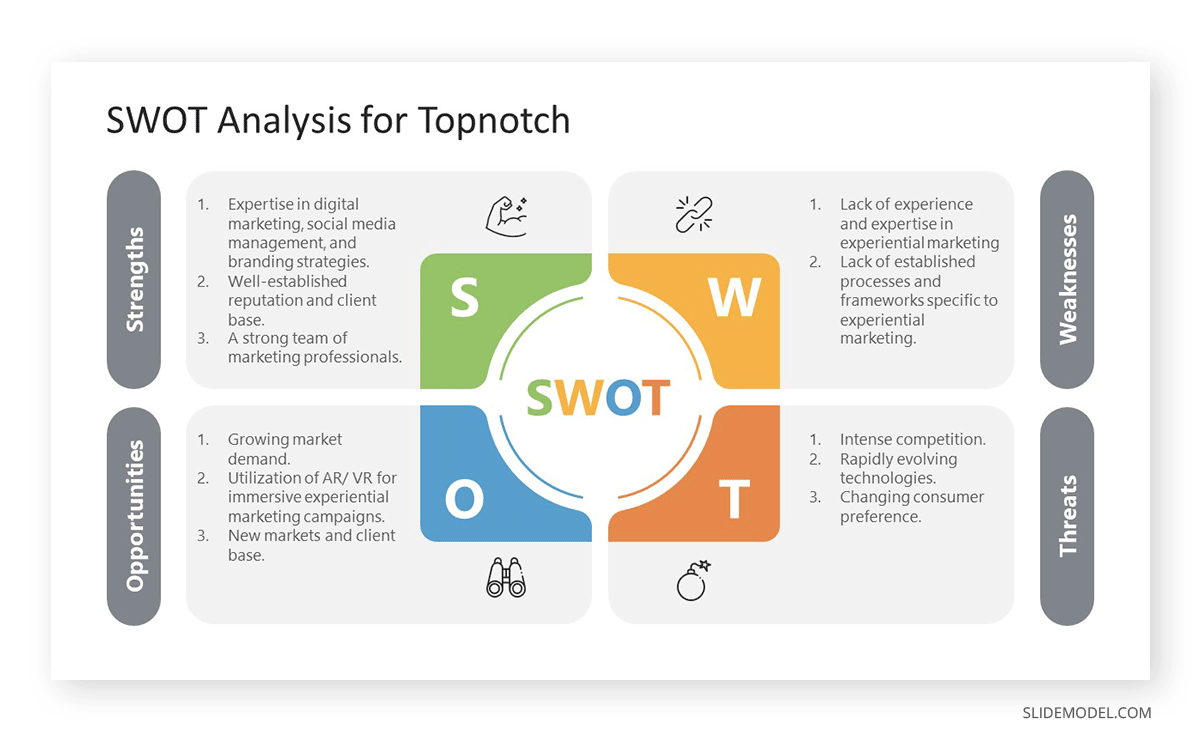
Using the TOWS template, let’s evaluate the different business strategic options the fictitious marketing agency has about the results of their SWOT analysis in marketing.
Strengths-Opportunities Strategies
- Capitalize on existing digital marketing and branding expertise to integrate experiential marketing into comprehensive, multi-channel marketing campaigns.
- Leverage the established client base to upsell experiential marketing services and expand revenue streams.
- Use a strong team of marketing professionals to develop unique and innovative experiential marketing strategies.
Strengths-Threats Strategies
- Leverage the well-established reputation and client base to maintain strong relationships with current clients.
- Provide continuous training to the marketing team to cope with emerging technologies.
Weaknesses-Opportunities Strategies
- Invest in training and skill development programs to enhance the team’s knowledge and capabilities in experiential marketing.
- Gain a deep understanding of AR and VR and how they can be applied to experiential marketing campaigns.
Weaknesses-Threats Strategies
- Gradually enter the market by starting with smaller-scale experiential campaigns and gaining experience before expanding.
- Allocate resources and dedicate time to research and study experiential marketing thoroughly.
- Seek partnerships or collaborations with agencies or professionals specializing in experiential marketing.
Case Study: SWOT Analysis for Design Thinking
Our second case study is a little less conventional. It involves the application of a Design Thinking SWOT analysis. Although many business professionals label this tool for corporate and strictly business-related purposes, graphic designers, web designers, and creatives in general can get the benefits of applying a SWOT in design tasks. How, you may ask; the answer to this question is linked to maximizing the opportunities that a design project may bring to a customer.
To make this theory more relatable, we will consider this scenario.
La Lavende is a cosmetic brand specializing in natural-based, vegan cosmetic products. Their production strategy is to optimize skin care formulas by using only natural products, which can benefit a consumer base with allergic reactions to chemicals. The management group of La Lavende is seeking to give a refresher to their logo, as it doesn’t reflect the company’s core values. They intend to position the brand in new markets; therefore, their branding strategy is critical at this point.
A graphic design firm was hired for this process, but unlike their competitors, they took a different approach in the initial business meeting with La Lavende. These design professionals proposed to build a design SWOT analysis to tailor potential hidden gems in their branding strategy, as well as which strengths should be reflected in the company’s logo.

Once again, using the TOWS matrix, we will explore the strategic options derived from this rebranding process.
Strengths-Opportunities Strategies
- Highlight the natural and vegan-friendly origin of the products in the branding.
- Expand into new markets seeking vegan-based & organic products.
- Partner with other health-conscious and eco-friendly brands.
- Develop marketing materials that highlight the benefits of using natural-based products for skin care in the long term.
- Change the packaging strategy to use recycled materials and an improved eco-friendly approach.
Strengths-Threats Strategies
- Stay up-to-date with regulatory changes in terms of natural-based products.
- Hire professionals to minimize the risk of health reactions during the development and testing phases for the products.
Weaknesses-Opportunities Strategies
- Enlist the help of influencers to promote the products beyond the health-conscious market.
- Use materials/colors in the logo that differentiate La Lavende from its competitors.
Weaknesses-Threats Strategies
- Expand the current market base with a wider-audience marketing strategy. People outside the health-conscious users may not be aware of what La Lavende is (or if it even exists).
- Develop a compliance plan for regulatory changes.
Presenting SWOT Analysis
Presenting a SWOT analysis to the stakeholders is no different from other presentation types – clarity should be the priority of the presenter.
The objective of the SWOT analysis should be explained from the get-go, and the scope of the analysis should be. That explanation should also include a brief overview of the methodology used to conduct the activity, such as the factors considered and data sources.
Then, discuss the key findings of the analysis. The negative conclusions may elicit negative reactions from the audience, so it’s paramount to present each point with evidence to support them.
Instead of dwelling solely on the negative aspects, emphasize the opportunities for improvement and growth. Highlight the key insights or patterns from the analysis, suggest specific actions that build on the strengths and opportunities, and address weaknesses and threats.
The quality of your visual aid may also enhance the overall effectiveness of your presentation. However, designing your presentation from scratch can take time. You may use ready-made templates instead to save time and benefit from professionally designed visual aids for your SWOT analysis.
SWOT Analysis Alternatives
NOISE Analysis
NOISE analysis is a strategic tool for Needs, Opportunities, Improvements, Strengths, and Exceptions. It is a suitable alternative for the SWOT matrix because it focuses on potential solutions and analyzes a situation.
PEST Analysis
PEST is an acronym for Political, Economic, Social, Technological, Environmental, and Legal. It is a good alternative to the SWOT analysis tool if your goal is to investigate how external factors can impact your organization. It helps organizations understand the potential opportunities and threats of the landscape in which they operate.
SCORE Analysis
The SCORE analysis stands for Strengths, Challenges, Options, Responses, and Effectiveness. It is practically the same as SWOT in that it also analyzes the internal and external factors that come into play when achieving an organizational goal. Unlike SWOT, however, it goes beyond identifying the problem by exploring solutions.
SWOT Analysis Examples & Presentation Slides
Conclusion
Performing a SWOT analysis goes beyond simply listing an organization’s strong and weak aspects. A structured approach helps organizations better understand their internal capabilities and external considerations. With these insights, businesses should be able to make informed decisions that may impact their success. Hopefully, this article helps you utilize SWOT the right way.

